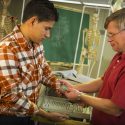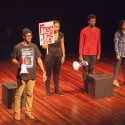Visiting artist to connect art students to the real world
University art students, who have yet to confront with the harsh realities of making it as a professional artist, have much to learn from those who have walked the line between the proverbial "starving artist" and making a good living in art.
Students know from their professors’ experience that teaching can pay the bills, but they might not be aware of the other creative ways to survive and thrive in the art world.
J. Morgan Puett, who patches together a living through short-term teaching stints, sales from her clothing collections, and long-term art projects, will bring that experience to the UW–Madison Art Department February 4-16 as a Harvey Shapiro Visiting Artist.
As a project artist, Puett believes that shared experiences through teaching and collaborative art projects are more important than having "static work in a museum."
"My work is about being involved with people," says Puett, who strives to include teaching as part of her mission as an artist.
Harvey Shapiro created this visiting artist program a year ago after the UW–Madison alumnus returned to campus after 35 years to tour the Art Department facilities and visit with students and faculty.
The trip solidified Shapiro’s desire to fund a visiting-artist program that would enrich students’ lives by bringing professional artists to campus for longer periods than the department’s weekly one- to three-day artist visits.
"I wanted to combine a university education with the real world, so students at Wisconsin could see what it’s really like as a working artist," he says. "There’s a different level of communication you can have when a person is not your professor. I hope what the visiting artists will do is tell students what it takes. It isn’t all glorious."
Puett describes the artist-in-residence program as "unique" among university art departments because the one- to two-week time frame is the most working artists can usually fit into their schedules while also allowing sufficient time to engage students in meaningful ways.
"It’s the best way to get texture in an art department," she says, adding that she looks forward to having the flexibility to engage with students in field trips, readings, and other collaborative projects.
"I hope I will be able to shift their perceptions of what an art practice is," she says. "That means to talk about their lives … why they want to be artists and how they can be artists in today’s dark world."
Students have responded well to the residency program because it gives them a true perspective on living as an artist outside academia, says sculpture professor Aris Georgiades. "It’s good for the students to see artists and hear them talk about practical issues."
Puett will discuss her work in a public lecture on Tuesday, February 12 as part of the Art Department’s 2007-08 weekly lecture series, New Forms, Big Ideas: Contemporary Practice in the Arts. The lectures — held in Room 204, Educational Sciences Building, 1025 W. Johnson Street — are free and open to the public.
Aspects of Puett’s childhood in rural Georgia saturate her trans-disciplinary work, which straddles the lines between fashion, architecture, and fine art. She received her B.F.A. and M.F.A. in sculpture and experimental filmmaking at The School of the Art Institute of Chicago.
Other artists scheduled for the spring semester lecture series are:
- January 29: Photographer Justine Kurland;
- February 5: Conceptual artist Mel Ziegler;
- February 19: Painter Cristi Rinklin and sculptor Andrew Mowbray;
- February 26: New media artist Ryan Griffis;
- March 11: Multi-media artist Paul Pfeiffer;
- March 25: Photographers John Shimon and Julie Lindemann;
- April 1: Graphics artist Sarah Kanouse;
- April 8: Metalsmith Sondra Sherman;
- April 15: Gallery curator Shane Campbell; and
- April 29: Blacksmith Tom Joyce.
Funding for the series also has been provided by the Brittingham Fund and the Anonymous Fund.


